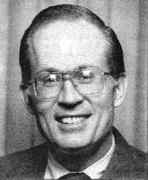Person: Black (2), Fischer Sheffey

Fischer Black was an American mathematical economist, best known as one of the authors of the famous Black–Scholes equation.
Mathematical Profile (Excerpt):
- A Nobel Prize is not awarded posthumously but Fischer Black would undoubtedly have been a joint winner of the 1997 Nobel Prize for Economics had he lived.
- In 1959, Fischer Black earned his bachelor's degree in physics.
- Black started working on the CAPM with respect to both empirical and theoretical work.
- Black viewed the excess return on an individual stock as being linked to the riskiness of that stock, otherwise no-one would buy the stock.
- In 1969, Black founded his own consulting firm, Associates in Finance.
- Black and Scholes worked intensely on this problem, from 1968 to 1971, in a friendly competition with a student of Samuelson's, Robert Merton.
- From 1972-75, Black was at the University of Chicago, Graduate School of Business first as visiting professor and then as a full professor.
- The greatest jewel in Black's crown is undoubtedly the celebrated Black-Scholes formula.
- Merton pointed out to Black and Scholes that, if all randomness/riskiness was eliminated, the portfolio would have to return the risk-free interest rate, otherwise there would be an opportunity for a free lunch (an arbitrage opportunity).
- The other way, is the method originally used by Black and Scholes and is given in their paper as an "Alternative Method" .
- By 1969, Black and Scholes had the above differential equation.
- But Black and Scholes had noticed the curious absence (in the differential equation) of the investment return, μ, of the stock-price or any parameter representing the degree of preference, as to risk, on the part of option purchasers.
- But when Black and Scholes set μ equal to the risk-free rate, rrr, and set purchasers to require a return from the stock-option also of the risk-free rate, rrr, i.e. the return was the risk-free rate, irrespective of the purchaser's risk preferences, they found that Sprenkle's formula, with these adjustments, satisfied the partial differential equation.
- As Black himself is quoted as saying ...
- It is clear that the unexpected aspect of the Black-Scholes-Merton differential equation was not at first accepted.
- Although this at first seemed hard to understand (even to Black and Scholes) in due course, it was realised that they and Merton were right and the stock-option price was independent of the stock-price return or investor preferences, as they were all incorporated into S(t)S(t)S(t) i.e. they did not enter f(S,t)f (S, t)f(S,t) other than through S(t)S(t)S(t).
- Black, Scholes and Merton could not have realised, at the time, the enormous repercussions that this realisation was to have.
- In 1975, Black left the University of Chicago to teach at MIT Sloan School of Management.
- The expected value of the forward-price at time TTT, was shown to be equal to the current forward-price and this enabled Black's formula to be shown to be exact under log-normal assumptions for the forward-price (of the underlying asset) under the forward-measure.
- Thus, under appropriate assumptions, Black's extended 76-formula was shown to be exact, even allowing for interest rates to be stochastic.
- Black's extended 76-formula enabled the valuation of caps (i.e. an upper bound for the applicable forward interest rates) on interest rates (assumed to be log-normal under the 'forward measure') and swaptions (option on the swap rate, being the coupon rate on a par bond commencing at the exercise date of the option) assuming the forward swap rate is log-normal under the so-called forward annuity measure.
- In 1984, Black who always had a practical streak, was invited to join Goldman Sachs on Wall Street.
- Black was also active in the field in interest rates research where one of the problems was how to model the yield curve.
- Black embodied the ideas of a true scholar and was quite ready to abandon a position, and admit being in error, when this was demonstrated convincingly to him.
- In 1994, Black was diagnosed with throat cancer.
- Surgery at first appeared successful and Black was well enough to attend, in October 1994, the annual meeting of the International Association of Financial Engineers where he received their reward as Financial Engineer of the Year.
- But the cancer returned and Black died on 30 August 1995.
- The Black-Scholes formula, of the same date, was a memorable landmark in the history of finance.
- Without the Black-Scholes formula, only a small set of brave people would have been comfortable with using options in their day-to-day life.
- After the work of Black, Scholes and Merton, options, and their pricing, were reduced to simplicity and clarity.
- The financial derivatives industry today, which trades trillions of pounds a year, is built on the mathematical methods which were pioneered by Black, Scholes, Merton and Bachelier.
Born 11 January 1938, Georgetown, Washington DC, USA. Died 30 August 1995, New York, USA.
View full biography at MacTutor
Tags relevant for this person:
Origin Usa
Thank you to the contributors under CC BY-SA 4.0! 

- Github:
-

- non-Github:
- @David-O-Forfar
References
Adapted from other CC BY-SA 4.0 Sources:
- O’Connor, John J; Robertson, Edmund F: MacTutor History of Mathematics Archive
